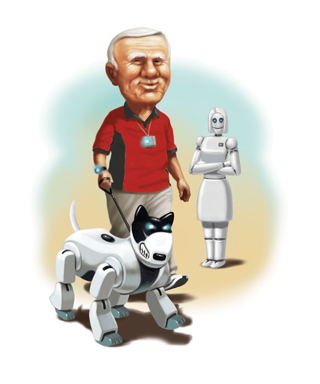
The assisted living sector promotes itself as a living environment for seniors that affords residents as much freedom, independence and lifestyle latitude as possible in order for them to live happily while still getting the medical and personal care they need. Yet as the healthcare landscape shifts, assisted living facilities are finding themselves inundated by an influx of higher acuity residents — especially those with Alzheimer’s and dementia.
This growing population of people needing memory care services presents a challenge for operators in balancing the freedom they promise with the security they need. Fortunately, technology advancements now allow facilities to keep residents safe without making them feel like they are being held hostage, security experts say.
“In many respects, the key concerns have remained consistent over the years — personal or medical emergencies, duress, wandering, falls and general facility security,” says Steve Elder, senior marketing manager for
STANLEY Healthcare. “What’s changing is a greater focus on the individual situation of each resident. Facilities are looking for technology that will allow them to better understand and meet the needs of each resident.”
Wandering and fall prevention are the biggest growth areas of the security market overall, Elder says, as more assisted living facilities investigate potential systems that are affordable, unobtrusive and effective.
“Fortunately, the technology has been moving in this direction, with systems offering far more integration options than in the past,” Elder says. “For example, ‘emergency call’ solutions can now be extended to cover wander and fall management so that assisted living facilities don’t need to invest in three separate systems.”
Discretion paramount
To preserve each resident’s dignity, security systems need to be practically invisible around the facility. Nothing screams “institution” like overtly placed cameras and alarms.
In today’s security climate, there is no need to have devices out in the open for all to see, Elder says. It is now possible to conceal them without sacrificing safety.
“It is preferable to keep infrastructure like door monitors and readers as discreet as possible or hidden altogether behind drop ceilings,” he says. “Some facilities are becoming very creative with this, using wall sconces instead of traditional dome lights for their nurse call system.”
Reducing audible alarms is another major trend, Elder says, because there are many options to send alerts directly to caregivers via hand-held and wearable devices.
RF Technologies’ CodeWatch transmitter is such a device. Using radio frequency identification technology, the tracking device is worn by residents deemed to be at risk for “elopement.” Worn around the wrist, the device resembles a wrist watch and sports decorative faces like the American flag and forget-me-not flower.
When a resident wearing a transmitter comes within range of a monitored exit, near-door antennas register the transmitter’s presence and communicate with a door controller to secure the exit.
“The addition of colorful CodeWatch transmitters and banding is not only a wonderful way to increase acceptance by memory care residents, but they’re something our customers have been asking for,” says Michelle Dalton, marketing director for RF Technologies. “We’re committed to providing our customers with discreet solutions that help them keep those under their care safe. Communities can also let their residents choose which transmitter and banding color they prefer, helping residents embrace the security measure.”
Smart sensors
Another clandestine security device is the QuietCare system from GE-Intel Care Innovations. About the size of a quarter, the motion sensor technology is programmed to study resident lifestyle routines and detect variations from the patterns it establishes.
“Any changes in resident patterns are transmitted to caregivers, who can respond and intervene if necessary,” says Bryce Porter, the company’s Americas sales manager. “This system allows for a more proactive, preventative level of care that reduces risks of falls or injury.”
By giving caregivers a window into each resident’s routines, the QuietCare system improves upon the conventional reactive method of responding when something has already happened.
“The name of the game has always been about how fast staff members can respond,” Porter says. “This system detects anomalies before they can turn into an emergency.”
For instance, if there is a significant increase in bathroom frequency at night, the system detects that and notifies staff. This intervention could preclude serious injury or illness, Porter says.
‘Peace of mind’
A concealed, unobtrusive security system can be a major selling point for prospective residents and their families on how the facility values the dignity and security of its population, Elder says.
“It is essential to demonstrate the benefits to residents and their families, showing how technology can actually empower residents, giving them more choice,” he says.
Porter adds: “The main pitch is that a sound security system enhances the lifestyle that assisted living offers. Because the clientele coming into today’s assisted living facility has more medical and personal needs, it gives them peace of mind knowing that they can have proper care and safety while preserving their dignity and independence.”



